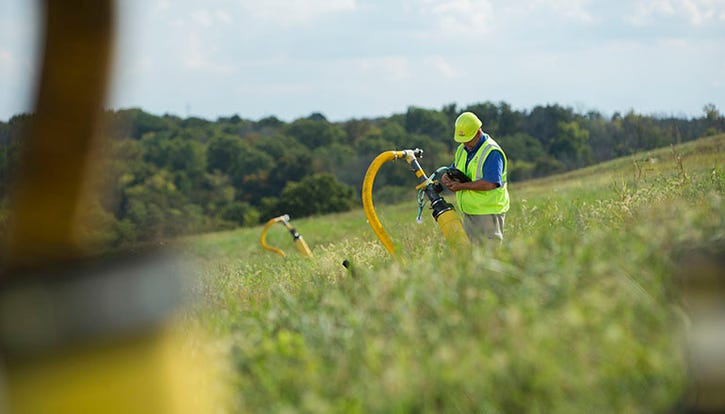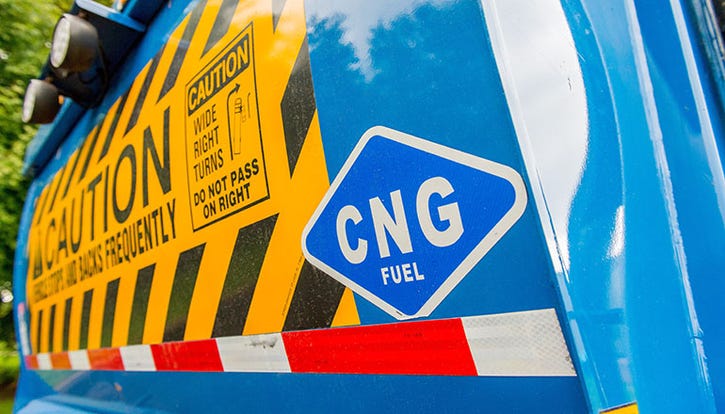Republic’s Evolving Sustainability Story and Future Targets
Pete Keller, vice president of recycling and sustainability at Republic Services, sheds light on how the company is working to reach its sustainability targets.

A couple decades ago, the concept of sustainability wasn’t in Republic Services’ lexicon. Now, as with many waste management companies, its focus on sustainability is front and center in its daily operations and long-term strategic planning.
With a large footprint and both a balance sheet and commitment level that run deep, the corporation has made large strides, focusing especially on materials recovery, reducing greenhouse gas emissions and beneficial use of gas.
Republic processes roughly 6 million tons of recyclable material annually. It operates 75 renewable energy projects at landfills and is exploring new and emerging beneficial uses for landfill biogas.
It continues to expand its fleet that runs on compressed natural gas (CNG) and renewable natural gas to reduce emissions. And it continues to invest in technologies to manage organics while creating products, such as anaerobic digestion and composting.
Republic met all the goals in its first formal sustainability plan and has since developed a new plan, which stretches over 12 years and lays out some rather ambitious goals with a 2030 target.
Waste360 recently spoke with Pete Keller, vice president of recycling and sustainability at Republic Services, to learn what those goals are and what drove them. Keller sheds light on how Republic is working to reach for these targets, and he discusses benefits and challenges of working to move the needle as such a large corporation.
Waste360: How long have you been with Republic, and where was the company with its sustainability focus in your early days?
Pete Keller: I’ve been with Republic for almost 22 years. Sustainability wasn’t in our lexicon when I came on board. We talked about environmental protection and stewardship, but we weren’t necessarily building strategy around that. Our industry was highly fragmented, and a lot of mergers and acquisitions were happening. We were operational-minded, focusing on integrating multiple family-owned businesses into ours.
It was around 2009 that we published our first sustainability report. And we laid down our first sustainability goals in 2014, which were five-year goals. We were looking at increasing capacity and markets for recyclable material. And we had goals to reduce emissions from our fleets.
Waste360: Did you accomplish all your first sustainability goals?
Pete Keller: Yes. We achieved all the timebound goals in our 2014-2019 plan by the end of 2018, making it a milestone year for us.
We added more than 150,000 tons per year of recycling capacity. We reduced absolute fleet emissions by 3 percent through compressed natural gas and renewable natural gas. Today, more than 20 percent of our overall fleet operates on natural gas, including the majority of our vehicles in California. In addition, we brought multiple landfill gas-to-energy projects online to produce energy for utilities.

Waste360: Your newest sustainability targets are for 2030 (over 2017 metrics). What are some primary goals?
Pete Keller: One sustainability goal is working toward a circular economy by increasing recovery of recyclables by 40 percent. That includes blue bin materials like cardboard, plastics and metals, as well as organics, biogas and oil.
Another goal is to increase gas that goes to the grid, whether for electricity or for transportation fuel in the form of renewable natural gas. We want to increase gas for these beneficial uses by 50 percent by 2030.
A third major goal is a 35 percent reduction in greenhouse gases by that same date.
Waste360: Can you elaborate on Republic’s 35 percent greenhouse gas reduction goal and how you are working to reach it?
Pete Keller: That figure represents reduction of both Scope 1 and Scope 2 greenhouse gas emissions by 35 percent by 2030. Scope 1 is emissions directly related to our operations, such as landfilling. Scope 2 is indirect emissions as a result of our operations, like energy usage.
A 35 percent reduction is an ambitious goal, especially since we expect to increase our trucks and other assets and expand our employee base. We will reach for that target, regardless of growth that can contribute to greenhouse gas, and that will make it more challenging.
We will employ varied approaches, many of which will involve technology. Next year, we will try out an electric truck in partnership with Mack Trucks. We are also working to get more organics out of the stream and are managing more of this material through anaerobic digestion and composting. Each year, we collect and compost 830,000 tons of organic waste nationwide. In California, we separated packaging and other material from food waste from restaurants and grocers and transported most of it to a composting facility or anaerobic digestion facility to make biogas. We are engaging in these processes today and expect to do more in the future.
Waste360: What’s the plan to accomplish a 40 percent increase in recycling by 2030?
Pete Keller: We are leveraging technology to work toward this goal, too. Investments in technology and processing equipment enable us to produce at a higher quality and process more tons, all at less cost. It’s a big investment, but we are looking at longer term, and that’s one way we will achieve our 40 percent goal.
We have acquired optical scanners and sorters, which are getting smarter and faster with higher capture rates. We also employ newer, high-speed digital camera technology where software is part of the system, so you can teach the camera to recognize materials.
There have been advances in robotics, which we have invested in that separate mechanically with a robotic arm. These units are getting faster, a little less expensive and more durable. And we are doing R&D [research and development] with manufacturers in our recycling facilities to help them continue to improve their technologies into the future.
Waste360: Please explain how you are increasing beneficial reuse of biogas. Can you also share market projections for these products?
Pete Keller: We collect landfill gas at all 190 of our active sites. Some sites are small, so there is not a lot to collect. Some are large, but not all of them have close access to the grid. So, although we capture high volumes, it’s not financially viable to send it for beneficial use. In those instances, gas is flared to avoid emitting methane into the atmosphere.
To reach our goal of a 50 percent increase in gas to the pipeline, we are looking at small solutions. One is mini turbines where landfill gas would spin the turbine and make electricity. This option is more economically viable now than five years ago, so it’s likely we can do more smaller projects in the future than we have in the past.
We also run our CNG collection trucks on our biogas. We will operate an additional 156 CNG-powered trucks by the end of 2019, bringing the total number of our vehicles running on alternative fuels to more than 3,100.

But again, we are interested in getting as much of this biogas into the pipeline as we can. And now there are more market incentives to make this feasible, whether Renewable Identification Numbers or credits available through California’s low carbon fuel standard program. Oregon now has a low carbon fuel standard, and more states are considering similar incentives. So, we see more opportunity in the future.
Waste360: What have your stakeholders been most interested in, and how has that influenced your sustainability goals?
Pete Keller: Climate is a concern and will continue to be. But now stakeholders are interested in adoption of sustainability practices across the entire supply chain; in other words, the people we do business with and the people who do business with us.
They are also interested in longer term planning, so our new goals are 12-year goals. Companies with rigorous sustainability objectives and long-term strategies generally outperform those that lack such planning.
Still, we have to be mindful of a changing landscape. We may encounter challenges along the way that require us to think or act differently, and we will adjust our course of action as needed. What’s important today to our stakeholders might not be tomorrow.
Meanwhile, we are working on roadmaps for our goals. We’re not entirely sure how we’ll accomplish all the goals by 2030, but we have a plan, and we’re going to work the plan.
Part of why we built our goals around a 2030 timeframe is that it's the timeframe for the United Nations’ Sustainable Development Goals, which are designed to meet the environmental, political and economic challenges facing the world today. Not only did we align with the United Nations' timeframe, but we aligned with four of their goals, such as Climate Action and Sustainable Cities and Communities. We did this because it’s important to us that our goals reflect broader societal concerns.
Waste360: What are advantages and challenges of being such a large corporation as you focus on sustainability?
Pete Keller: As a large company, we are financially strong with a big footprint, so we have the ability to scale and make progress, which moves the needle for the industry. We are in a position to create long-term strategies that are good for our customers, shareholders and the environment.
As far as challenges, we are in 41 states and Puerto Rico, and regulations are different from state to state. Also, the attributes, whether environmental or economical, are not the same in all locations, which can present challenges. So, while we can scale solutions, it’s not one size fits all. That means when we create strategies from headquarters, we have to be mindful there is no approach that will work everywhere.
Returning to the positives, as the business grows, so does our potential to drive change and positively impact the environment and society overall. We are raising the bar through our efforts, which we believe will strengthen the foundation of our business and continue to create long-term value for our stakeholders.
About the Author
You May Also Like




